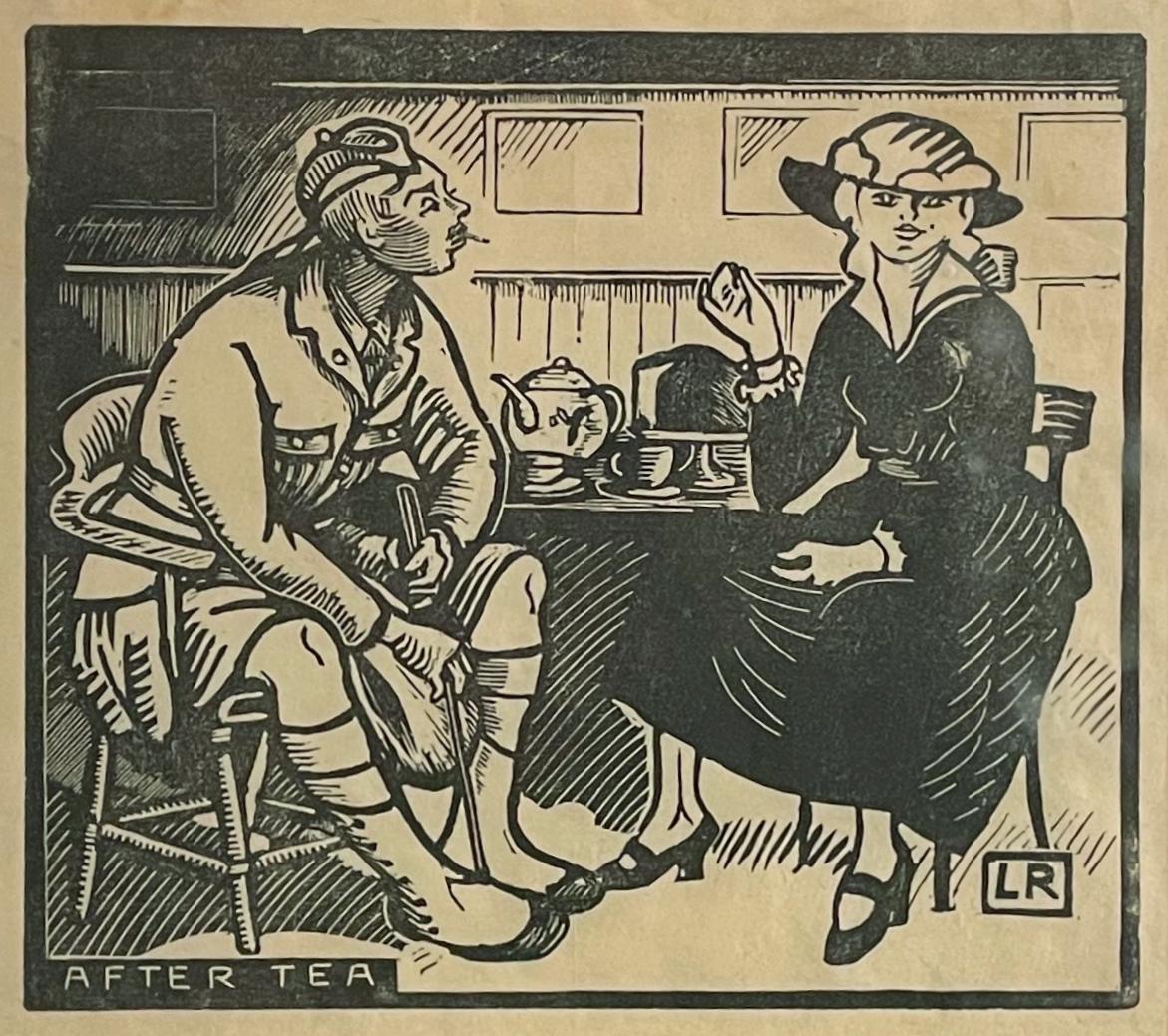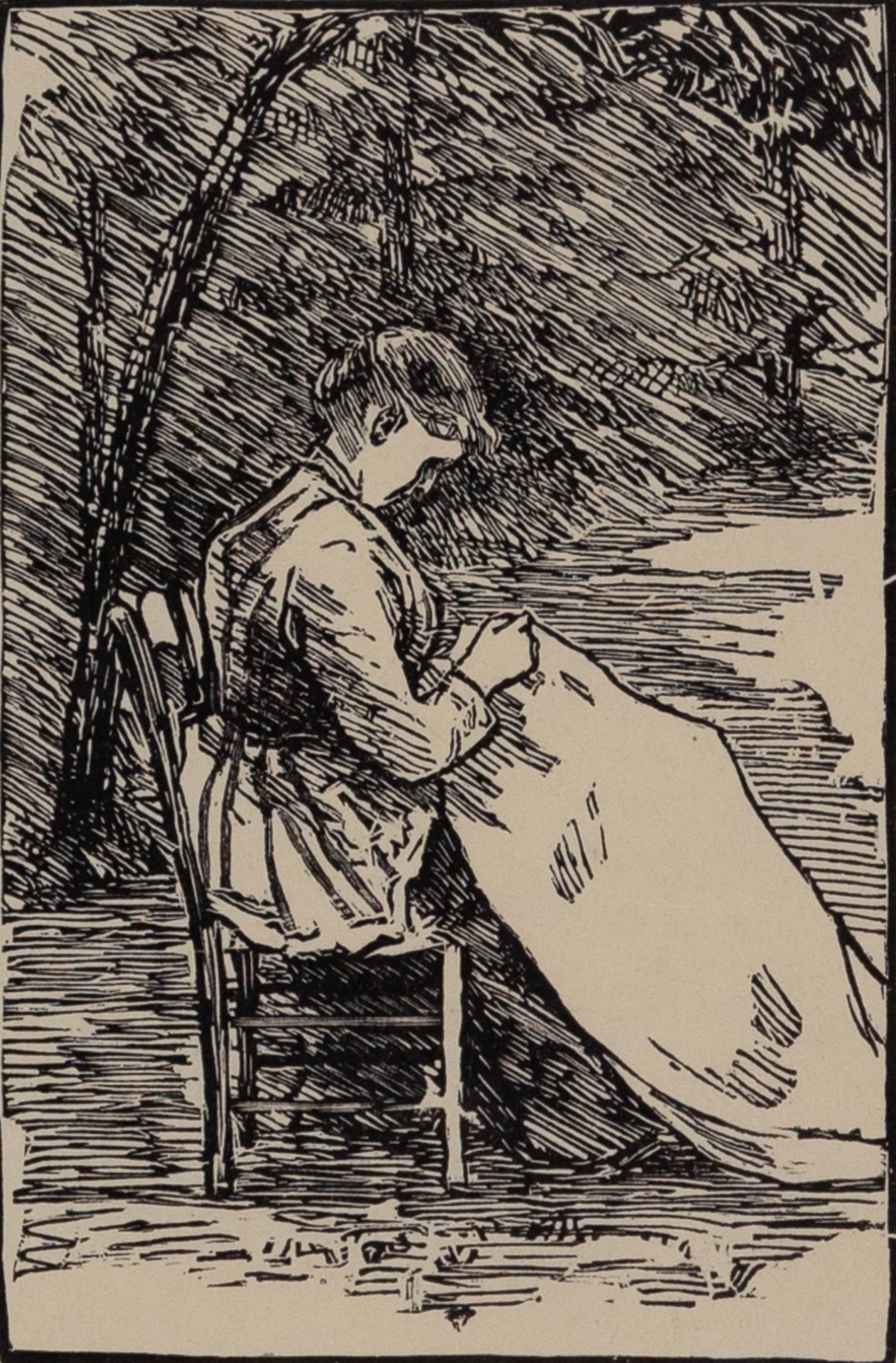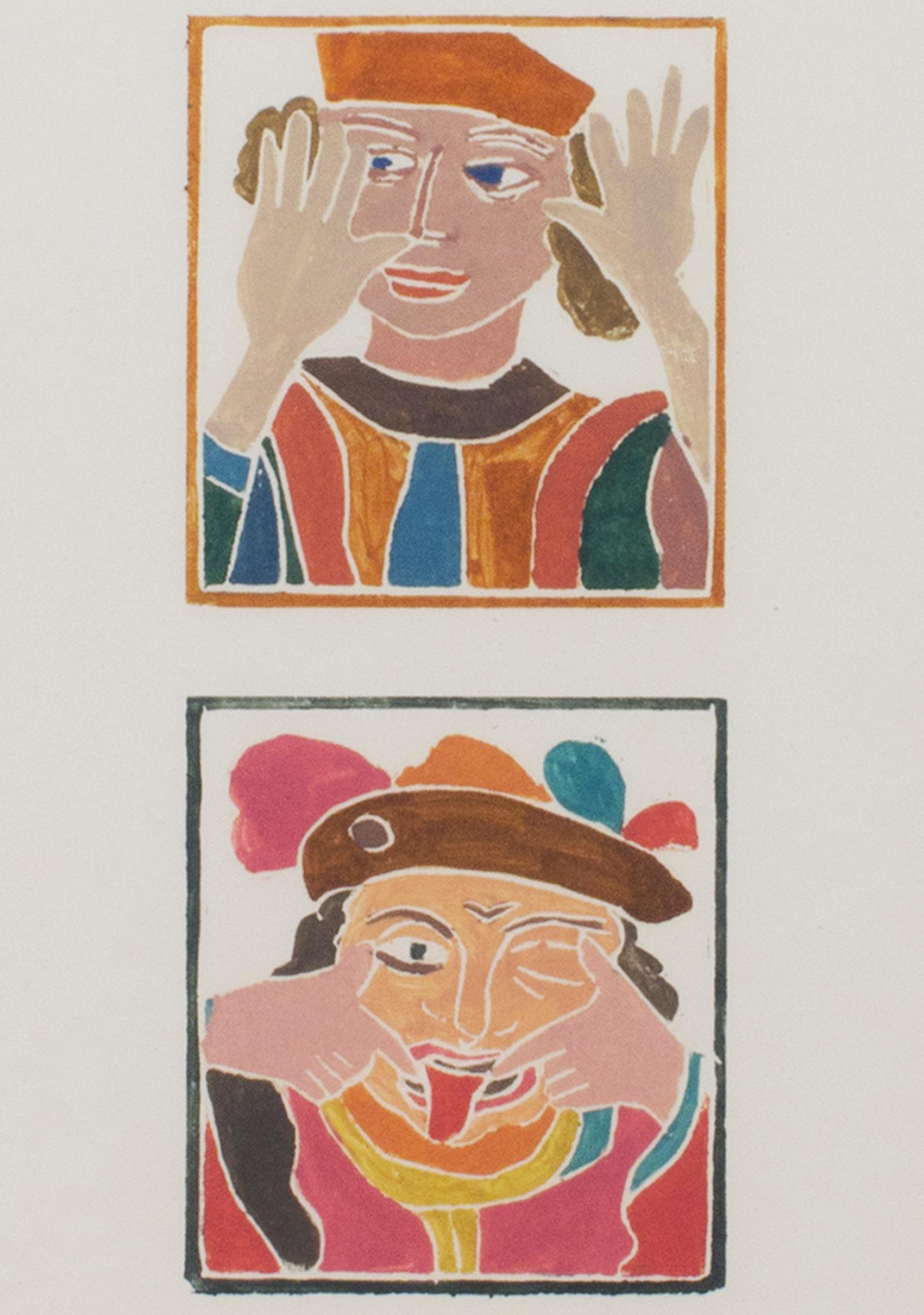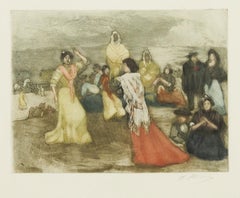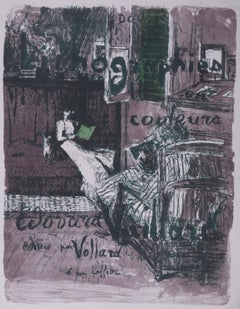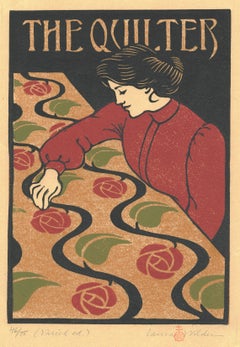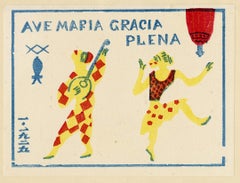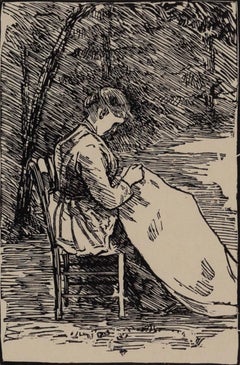Items Similar to Les Amateurs d'Estampes
Want more images or videos?
Request additional images or videos from the seller
1 of 8
Félix VallottonLes Amateurs d'Estampes1892
1892
$775
£589.60
€689.42
CA$1,083.87
A$1,217.61
CHF 648
MX$15,056.18
NOK 7,895.91
SEK 7,634.21
DKK 5,142.43
Shipping
Retrieving quote...The 1stDibs Promise:
Authenticity Guarantee,
Money-Back Guarantee,
24-Hour Cancellation
About the Item
Les Amateurs d'Estampes
Woodcut, 1892
Initialed in the plate lower left
Titled below image: "Gravure originale sur bois par F. Vallotton"
Reference: Valloton and Goerg 107c, with the purple address stamp upper right center (see photo)
Condition: Excellent
Aging to sheet
One spot of printers ink outside of the image in the upper margin
Block size: 7 3/8 x 10 inches
Sheet size: 10 1/8 x 12 3/4 inches
Condition: Very good, aging (yellowing) to the paper, more pronounced at the edges of the sheet
Provenance: Edmund Sagot (1881-1917), noted Parisian art dealer and print publisher
By decent
Vallotton was a noted member of the Nabi, highly regarded for his paintings and original woodcuts. His works are in most major museums.
An impression of this image is in the collection of numerous museums.
Thank you for your interest in the Vallotton woodcut, Les Amateurs d’Estampes (Print Lovers).
It depicts print collectors admiring the new offerings in the window of the Sagot Gallery in Paris.
The woodcut is the second published version of the address card for Edmund Sagot the noted Paris art gallery with the change of address in lavender ink. It had moved and hence the change of address was necessary for publicity.
The woodcut was created in 1892. It is unsigned as all the address cards are. There are two size variants, this being the larger of the two. It is printed on a tan wove paper. It is in excellent original condition.
The provenance is from the Heirs of Edmund Sagot (1857-1917). by decent. The Sagot family was noted for selling posters, fine prints and original works of art. Edmund’s brother Clovis, was Picasso’s first dealer in Paris.
The image is documented in the Vallotton and Goerg catalog raisonne in entry 107c
Impressions of this image can be found in many museums including:
Bibliothèque nationale de France
De Young/Legion of Honor/Fine Art Museums of San Francisco
Newfields, Indianapolis Museum of Art
National Gallery of Australia
Musee Des Beaux-Arts du Canada
Van Gogh Museum
Museum of Fine Arts, Houston
Portland Art Museum
Kunst Museum, Holland
Philadelphia Museum of Art
Yale University Art Gallery
Félix Vallotton, in full Félix Edouard Vallotton, (born December 28, 1865, Lausanne, Switzerland—died December 28, 1925, Paris, France), Swiss-born French graphic artist and painter known for his paintings of nudes and interiors and in particular for his distinctive woodcuts.
Vallotton was raised in a traditional bourgeois and Protestant household. After completing secondary school, he left Lausanne in 1882 for Paris to pursue art studies. Though he was accepted by the École des Beaux-Arts, he chose to attend the less traditional Académie Julian, where he studied with French painters Jules Lefebvre and Gustave Boulanger and enjoyed virtually free rein over his pursuits. He took the opportunity to study graphic arts—lithography and other methods of printmaking. He exhibited publicly for the first time in 1885 at the Salon des Artistes Français—the oil painting Portrait of Monsieur Ursenbach, the subject of which was an American mathematician and neighbour of the artist. In 1889 Vallotton exhibited at the Exposition Universelle in Paris as the representative from Switzerland and won honourable mention for the same portrait.
"The Starry Night," oil on canvas painting by Vincent van Gogh, 1889. In the Museum of Modern Art, New York City. 73.7 x 92.1 cm. (Post-impressionism)
Britannica Quiz
Famous Paintings Quiz
While at the Académie Julian, Vallotton had become friends with and protégè of artist and printmaker Charles Maurin, who introduced him to the art of woodcut. Maurin also introduced Vallotton to the haunts of Montmartre—the cafés and cabarets such as Le Chat Noir, where he met artist Henri de Toulouse-Lautrec. Vallotton moved to live near Montparnasse, the city’s slumlike breeding ground for artists, poets, musicians, and writers, as he drew closer to Toulouse-Lautrec and the bohemian culture of Paris. To make ends meet, he began selling prints of drawings he had made after Rembrandt and Jean-François Millet. In 1890 he also began contributing art reviews to the Gazette de Lausanne, an appointment he maintained through 1897.
Vallotton worked in woodcut almost exclusively throughout the 1890s. In 1892 he began associating with a group of artists called the Nabis (from Hebrew navi, meaning “prophet,” or “seer”)—Édouard Vuillard, Pierre Bonnard, Ker-Xavier Roussel, and Maurice Denis. Vallotton exhibited with them for the first time that year at Saint-Germain-en-Laye. Though only loosely affiliated with the group, Vallotton, like them, looked to Symbolist artists and to the Japanese tradition of woodcut. Both stressed the flatness of the surface and the use of simplified abstract forms, strong lines (evident in Vallotton’s prints), and bold colours (evident in his paintings of the period, his Paris street scenes from the mid-1890s, for example). Of the paintings he completed in that period, Bathers on a Summer Evening (1892–93) attracted the most attention. That large-scale composition of women of various ages and in various stages of undress was exhibited at the Salon des Indépendants in spring 1893, and it shocked the crowds with its eroticism.
During the 1890s Vallotton also became more politically engaged and communicated his sentiments through his prints, which were printed in Paris’s literary and political publications such as Le Rire, Le Revue blanche, L’Assiette au beurre, and Le Courrier français, as well as in Pan (Berlin), Die Jugend (Munich), and the U.S. publications Scribner’s and The Chap-Book. He was particularly vocal about his support for Alfred Dreyfus at the time of the Dreyfus affair (1894). Valletton’s woodcut The Age of Paper (1898), published on the January cover of Le Cri de Paris, shows figures reading newspapers, all of which are Parisian publications known to be pro-Dreyfus. Other notable political woodcut prints include The Charge and The Demonstration (both 1893).
Vallotton used woodcuts for nonpolitical purposes as well. He worked in the medium to depict simple yet striking intimate interior scenes of nudes, bathers, romantic and sometimes private moments between couples, and musicians playing their instruments. His woodcuts attracted international attention and acclaim. Like the Nabi painters, Vallotton created many interiors (paintings and woodcuts), including his best-known series, titled Intimacies (published in La Revue blanche in 1898), 10 woodcuts depicting private marital moments that allude to adultery and deceit. He also designed a theatre playbook cover for Swedish dramatist August Strindberg’s The Father (1894) and served as illustrator for several books throughout the 1890s, such as Jules Renard’s The Mistress and Remy de Gourmont’s The Book of Masks (both 1896).
Get a Britannica Premium subscription and gain access to exclusive content.
In 1898 Vallotton was the subject of a monograph by German art critic Julius Meier-Graefe. In 1899 he married Gabrielle Rodrigues-Henriques, a wealthy Jewish widow, daughter of art dealer Alexandre Bernheim. Vallotton’s marriage not only landed him back in the bourgeois world in which he had been raised, but it also escalated his career, as he was given many opportunities to exhibit at his father-in-law’s Galerie Bernheim-Jeune. Vallotton became a naturalized French citizen in 1900.
Though he had been painting throughout his career, at the beginning of the 20th century he shifted his focus away from printmaking to oil painting, creating many nudes, as well as landscapes, still-life paintings, interiors, and portraits—all rendered in a simplified realist manner that has been likened to that of Gustave Courbet and J.-A.-D. Ingres. Vallotton painted portraits of members of the Paris cultural elite, including Félix Fénéon (1896), Thadée Natanson (1897), Ambroise Vollard (1901–02), Gaston and Josse Bernheim-Jeune (1901), Paul Verlaine (1902), and Gertrude Stein (1907), and the very large The Five Painters (1902–03)—a group portrait of Nabi artists Bonnard, Vuillard, Charles Cottet, Roussel, and Vallotton engaged in conversation around a desk. He painted his wife numerous times, usually involved in domestic activity. By 1907 Vallotton was also trying his hand at writing, penning a novel that year (La Vie meurtrière, published posthumously in 1930; “The Murderous Life”) and several unpublished plays over the course of several years.
Throughout the 1910s Vallotton exhibited his work regularly and, after nearly 15 years, returned to woodcut to produce the antiwar series C’est la guerre! (1915; “This is War!”). Increasingly consumed with the ravages of World War I, Vallotton applied and was accepted in late 1916 to be part of a group of artists to visit the front lines and witness the drama of war in person. Several works emerged from that experience, including Ruins at Souain and Verdun (both 1917), an abstract, Futurist-inspired depiction of battle. He also published in Les Écrits nouveaux the essay “Art et Guerre,” (1917; “Art and War”), in which he described the challenges of conveying the realities of war through art.
The last 10 years of Vallotton’s career were less successful. In ill health, Vallotton saw waning appreciation for his art. He continued to make art, however, until he died of cancer at age 60. Though he is most often associated with the Nabis, he never strictly aligned himself with the movement. He has proven difficult to categorize within the framework of art history, showing a range of influences—the Old Masters, Symbolism, Realism, Post-Impressionism, and Japonism (a movement that assimilated Japanese aesthetics). Art critics and historians credit Vallotton with reviving the art of woodcut, which was then adopted after 1905 by Expressionist artists such as Erich Heckel and Ernst Ludwig Kirchner and subsequently became a mainstay of modern art.
Naomi Blumberg for Encyclopedia Britannica
- Creator:Félix Vallotton (1865 - 1925, French, Swiss)
- Creation Year:1892
- Dimensions:Height: 10.125 in (25.72 cm)Width: 12.75 in (32.39 cm)
- Medium:
- Movement & Style:
- Period:
- Condition:
- Gallery Location:Fairlawn, OH
- Reference Number:Seller: FA52641stDibs: LU14015231282
About the Seller
5.0
Recognized Seller
These prestigious sellers are industry leaders and represent the highest echelon for item quality and design.
Gold Seller
Premium sellers maintaining a 4.3+ rating and 24-hour response times
Established in 1978
1stDibs seller since 2013
793 sales on 1stDibs
Typical response time: <1 hour
Associations
International Fine Print Dealers Association
- ShippingRetrieving quote...Shipping from: Fairlawn, OH
- Return Policy
Authenticity Guarantee
In the unlikely event there’s an issue with an item’s authenticity, contact us within 1 year for a full refund. DetailsMoney-Back Guarantee
If your item is not as described, is damaged in transit, or does not arrive, contact us within 7 days for a full refund. Details24-Hour Cancellation
You have a 24-hour grace period in which to reconsider your purchase, with no questions asked.Vetted Professional Sellers
Our world-class sellers must adhere to strict standards for service and quality, maintaining the integrity of our listings.Price-Match Guarantee
If you find that a seller listed the same item for a lower price elsewhere, we’ll match it.Trusted Global Delivery
Our best-in-class carrier network provides specialized shipping options worldwide, including custom delivery.More From This Seller
View AllSevillanas
Located in Fairlawn, OH
Sevillanas
Etching and color aquatint on laid watermarked paper, c. 1900
Signed by the artist in pencil lower right (see photo)
Editioned in pencil lower left corner of sheet
Publish...
Category
Early 1900s Post-Impressionist Figurative Prints
Materials
Aquatint
Couverture pour Douze Lithographies en Couleurs, ou Passage et Interieurs
By Edouard Vuillard
Located in Fairlawn, OH
Couverture pour Douze Lithographies en Couleurs, ou Passage et Interieurs
Color lithograph, 1896-1898
Unsigned (as issued)
From: Douze Lithographies en Couleurs, ou Passage et Interi...
Category
1890s Post-Impressionist Figurative Prints
Materials
Lithograph
The Quilter
Located in Fairlawn, OH
The Quilter
Color woodcut printed on cream color wove paper
c. 1990
Signed in pencil lower right (see photo)
Signed with the artist's stamp lower right in the pencil signature (see p...
Category
1990s Contemporary Figurative Prints
Materials
Woodcut
Ave Maria-Nanban Music
Located in Fairlawn, OH
Ave Maria-Nanban Music
Color woodcut with mica sprinkles, 1925
Signed Hide in image, Signed Kawanishi Hide on printed mount
From: Dojin zasshi, Hanga Magazine, Volume 5, No. 4
Condi...
Category
1920s Other Art Style Figurative Prints
Materials
Woodcut
The Bathers
By Winslow Homer
Located in Fairlawn, OH
The Bathers
Woodengraving, 1873
As published in Harper's Weekly, August 2, 1873 (p. 668)
Provenance:
Wunderlich & Co., Inc., New York, NY (Their stock no. 84.003.8 in pencil recto a...
Category
1870s American Realist Figurative Prints
Materials
Woodcut
Arashi Rikan II in an Osaka Kabuki Scene
Located in Fairlawn, OH
Arashi Rikan II in an Osaka Kabuki Scene
Color woodcut, c. 1827
Signed middle left (see photo)
Titled upper left (see photo)
Format: oban
Publisher: Honsei
The actor, in character, d...
Category
1820s Other Art Style Figurative Prints
Materials
Woodcut
You May Also Like
After Tea by Ludovic-Rodo Pissarro - Wood engraving
By Ludovic-Rodo Pissarro
Located in London, GB
After Tea by Ludovic-Rodo Pissarro (1878-1952)
Wood engraving
12 x 13.2 cm (4 ³/₄ x 5 ¹/₄ inches)
Initialled and titled in the plate
Executed circa 1917
Artist biography
Ludovic-Rod...
Category
1910s Post-Impressionist Figurative Prints
Materials
Woodcut
Woman Embroidering (Nini) by Lucien Pissarro - Woodcut
By Lucien Pissarro
Located in London, GB
Woman Embroidering (Nini) by Lucien Pissarro (1863-1944)
Woodcut
15 x 10 cm (5 ⁷/₈ x 4 inches)
Stamped with initials lower right
Numbered lower left, 18/20
Provenance: Private Colle...
Category
20th Century Post-Impressionist Figurative Prints
Materials
Woodcut
Set of Four Framed Wood Cut Prints After André Derain
By André Derain
Located in Pasadena, CA
Rare Set of Four Original Color WDCT Skira 1943 after RABELAIS (François).
The Horrible and Terrible Deeds and Prowess of the Renowned Pantagruel, King of the Dipsodes, Son of the ...
Category
1940s Fauvist Figurative Prints
Materials
Lithograph, Woodcut
$2,925 Sale Price
25% Off
Rare Set of Four Framed Wood Cut Prints After André Derain
By André Derain
Located in Pasadena, CA
Rare Set of Four Original Color WDCT Skira 1943 after RABELAIS (François).
The Horrible and Terrible Deeds and Prowess of the Renowned Pantagruel, King of the Dipsodes, Son of the ...
Category
1940s Fauvist Figurative Prints
Materials
Lithograph, Woodcut
Set of Four Framed Wood Cut Prints After André Derain
By André Derain
Located in Pasadena, CA
Rare Set of Four Original Color WDCT Skira 1943 after RABELAIS (François).
The Horrible and Terrible Deeds and Prowess of the Renowned Pantagruel, King of the Dipsodes, Son of the ...
Category
1940s Fauvist Figurative Prints
Materials
Lithograph, Woodcut
$2,340 Sale Price
40% Off
"The Court Jesters, " Two Woodcuts by Andre Derain
By André Derain
Located in Milwaukee, WI
"The Court Jesters" includes two original color woodcuts by Andre Derain. This is from an edition of 200. It features two vignettes of brightly-clad j...
Category
1940s Fauvist Figurative Prints
Materials
Woodcut
More Ways To Browse
Used Card Catalogs
Mid Century Card Catalog
Australian Antiques
Antique Drawing Desk
Les Pierre Antiques
Antique Drawing Instruments
Antique German Stein
Second Hand Antique Desks
Antique Writing Instruments
Post Master Desk
Antique Desks Canada
Antique Scale Pan
Antique Japanese Writing Desk
Antique Spring Scale
Paul Millet
Antique French School Desk
1900 School Desk
Antique Desk Philadelphia
